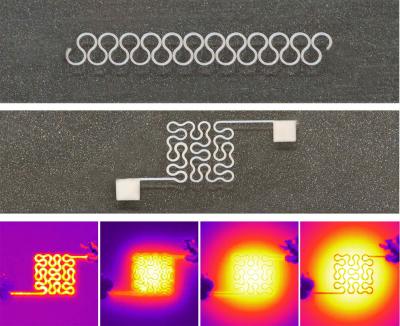New technique allows printing of flexible, stretchable silver nanowire circuits

These images show two printed silver nanowire patterns: a horseshoe (top) and Peano curve (bottom) design, with high resolution. The printing technique was used to make a prototype glove containing an internal heater. The bottom shows infrared images of the wearable heater going through an on-off cycle. Credit: Yong Zhu
Silver nanowires have drawn significant interest in recent years for use in many applications, ranging from prosthetic devices to wearable health sensors, due to their flexibility, stretchability and conductive properties. While proof-of-concept experiments have been promising, there have been significant challenges to printing highly integrated circuits using silver nanowires.
Silver nanoparticles can be used to print circuits, but the nanoparticles produce circuits that are more brittle and less conductive than silver nanowires. But conventional techniques for printing circuits don't work well with silver nanowires; the nanowires often clog the printing nozzles.
“Our approach uses electrohydrodynamic printing, which relies on electrostatic force to eject the ink from the nozzle and draw it to the appropriate site on the substrate,” says Jingyan Dong, co-corresponding author of a paper on the work and an associate professor in NC State's Edward P. Fitts Department of Industrial & Systems Engineering. “This approach allows us to use a very wide nozzle – which prevents clogging – while retaining very fine printing resolution.”
“And because our 'ink' consists of a solvent containing silver nanowires that are typically more than 20 micrometers long, the resulting circuits have the desired conductivity, flexibility and stretchability,” says Yong Zhu, a professor of mechanical engineering at NC State and co-corresponding author of the paper.
“In addition, the solvent we use is both nontoxic and water-soluble,” says Zheng Cui, a Ph.D. student at NC State and lead author of the paper. “Once the circuit is printed, the solvent can simply be washed off.”
What's more, the size of the printing area is limited only by the size of the printer, meaning the technique could be easily scaled up.
The researchers have used the new technique to create prototypes that make use of the silver nanowire circuits, including a glove with an internal heater and a wearable electrode for use in electrocardiography. NC State has filed a provisional patent on the technique.
“Given the technique's efficiency, direct writing capability, and scalability, we're optimistic that this can be used to advance the development of flexible, stretchable electronics using silver nanowires – making these devices practical from a manufacturing perspective,” Zhu says.
###
The paper, “Electrohydrodynamic Printing of Silver Nanowires for Flexible and Stretchable Electronics,” is published in the journal Nanoscale. The paper was co-authored by Yiwei Han, a Ph.D. student at NC State, and Qijin Huang, a former postdoctoral researcher at NC State.
The work was done with support from the National Science Foundation, under grants CMMI-1728370 and CMMI-1333775.
Media Contact
All latest news from the category: Power and Electrical Engineering
This topic covers issues related to energy generation, conversion, transportation and consumption and how the industry is addressing the challenge of energy efficiency in general.
innovations-report provides in-depth and informative reports and articles on subjects ranging from wind energy, fuel cell technology, solar energy, geothermal energy, petroleum, gas, nuclear engineering, alternative energy and energy efficiency to fusion, hydrogen and superconductor technologies.
Newest articles

Bringing bio-inspired robots to life
Nebraska researcher Eric Markvicka gets NSF CAREER Award to pursue manufacture of novel materials for soft robotics and stretchable electronics. Engineers are increasingly eager to develop robots that mimic the…

Bella moths use poison to attract mates
Scientists are closer to finding out how. Pyrrolizidine alkaloids are as bitter and toxic as they are hard to pronounce. They’re produced by several different types of plants and are…

AI tool creates ‘synthetic’ images of cells
…for enhanced microscopy analysis. Observing individual cells through microscopes can reveal a range of important cell biological phenomena that frequently play a role in human diseases, but the process of…





















